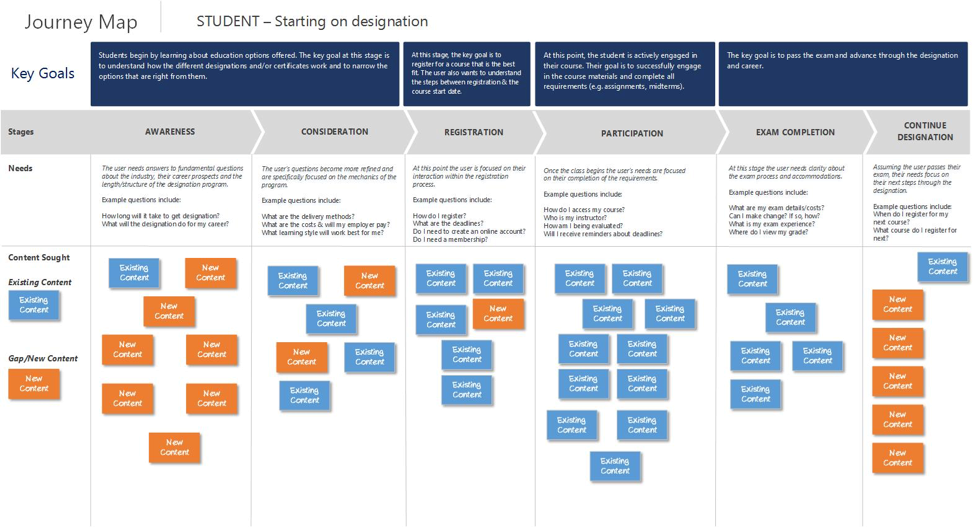dezembro 27, 2018
Journey maps are documents that illustrate an individual’s needs, their interaction with your organization and the resulting emotional state of the individual throughout the process.*
The ultimate goal is to ensure that the website supports the full customer lifecycle. The knowledge uncovered through the journey mapping exercise feeds directly into how we plan the site structure, the information architecture and the development road map so that we address the biggest pain points and quickest wins for your site visitors before any issues that do not directly affect the journey.
Too often the journey map is a neglected artifact once the project moves beyond the planning phase. I would argue that the journey map should be a living tool that becomes the backbone of all content planning and personalization strategies for your website content.
This guide has been developed to help marketers learn how to use journey maps to develop better content strategy – an improved content strategy that is designed to engage and convert your site visitors with content that supports their journey, rather than what your organization thinks they should have.
A customer-first approach
Creating the content strategy with the customer top of mind will give your team a clear roadmap of what content should be created and promoted through your channels. It should also help refocus content providers in your organizational that insist their content is the best, most important content.
Overall a user-focused content strategy will improve attraction, engagement and conversion rates on your site, along with providing a structure that will save your organization from investing in low return content.
Developing a journey map
The first thing you will develop is a persona for the journey map. A persona is an archetype of your typical website user. It represents a target audience for your website. Personas come in a range of “flavours”, from highly detailed and researched to “guerilla” personas, sketched from organizational knowledge of the user. If you are jumping right into the journey map exercise and your organization has a strong understanding of your user, I would focus on the guerilla persona. Outline the basics of the personas focusing on their goals, motivations and choice criteria.
Next, you will move on to fleshing out the details of the journey map. A journey map details all the action that a customer takes and the interactions they have with your organization. You will start by establishing the stages your user passes through on the way to completing a transaction with your organization. Once the stages are established you will dive into outlining:
- The questions asked by the user
- Tasks/activities completed by the user at each stage
- Concerns & expectations of the user
- Touchpoints - the method they are using to interact (i.e. website, newsletter, call center)
- A summary of the user’s experience (both positive and negative)
- Opportunities for improvement
Developing a content map
At the completion of the journey map, you have a baseline to begin making small and large improvements to the site and your customer’s experience with your organization through their journey. You also have the start of your content map. For each stage of the journey you will specify:
- A description of the persona’s key needs at each stage
- The content you have that supports the user
- How the user will use the content
- Any gaps in the content
You might choose to workshop this with your team. Your whiteboard should be set-up so your persona’s key goals, stage and needs at each goal are easily referred to. I recommend you use different coloured sticky-notes to identify Existing and Gap/New content.

You can see from this example that this method creates a strong visual for your team to see where your team has content that currently supports the customer journey and where you have gaps to fill.
You can also capture this in a spreadsheet. The spreadsheet is nice because you can also capture the purpose of the content in order to help focus your team through the content development process:
Journey Stage |
Stage Description |
Content Sought |
Purpose |
| Awareness |
The user needs answers to fundamental questions about the industry, their career prospects and the length/structure of the designation program. |
Additional Content Analysis
If you find that the content map does not provide enough detail to provide a complete view of the current state and gap analysis a deep-dive audit may be warranted.
The first step is to develop a comprehensive inventory of all your organization’s content and compare this to the list generated as part of the content map development. That means looking beyond your website to hard copy materials, app content, documentation, etc. This inventory should include the creation date, last updated date, and the targeted persona. It is also important to acknowledge whether or not this content is worth keeping, needs a rewrite, etc.
The next step is to assign each asset to the content map. Again, ask your team: Are there any gaps within the journey? Do you have too much content in a certain point of the journey? Is the content suited to supporting the user at that point in the journey?
Fact over emotion: The numbers don’t lie
You should also review your analytics to determine if the content is currently being used. Remember, it is only important if your user finds it useful and valuable. Politics should not come into play. Using data from your analytics will help you make fact based decisions rather than emotional decisions.
| Journey Stage Targeted | Persona Targeted | Content Title | URL | Format | Type | Status | Owner |
|
Assign one:
|
Assign one:
|
Assign one:
|
Assign one:
|
At this point you will have a:
- Detailed view of your persona
- Deep understanding of your customer’s journey
- A complete content list that prioritizes your customer’s needs
- An audit of your existing content and gaps that need to be filled
This provides you with the structure you need to begin drafting content to meet your different personas’ needs and aligns with your organization’s goals.
Post-script
Posting your new content to the site is not the end. You should ensure you have a:
- Review plan for the personas tied to organizational goals & objectives
- Review plan for content freshness and relevancy
- Analytics tracking plan
You can also extend your content strategy to:
- Content personalization engagement plans
- Content profiling strategies








